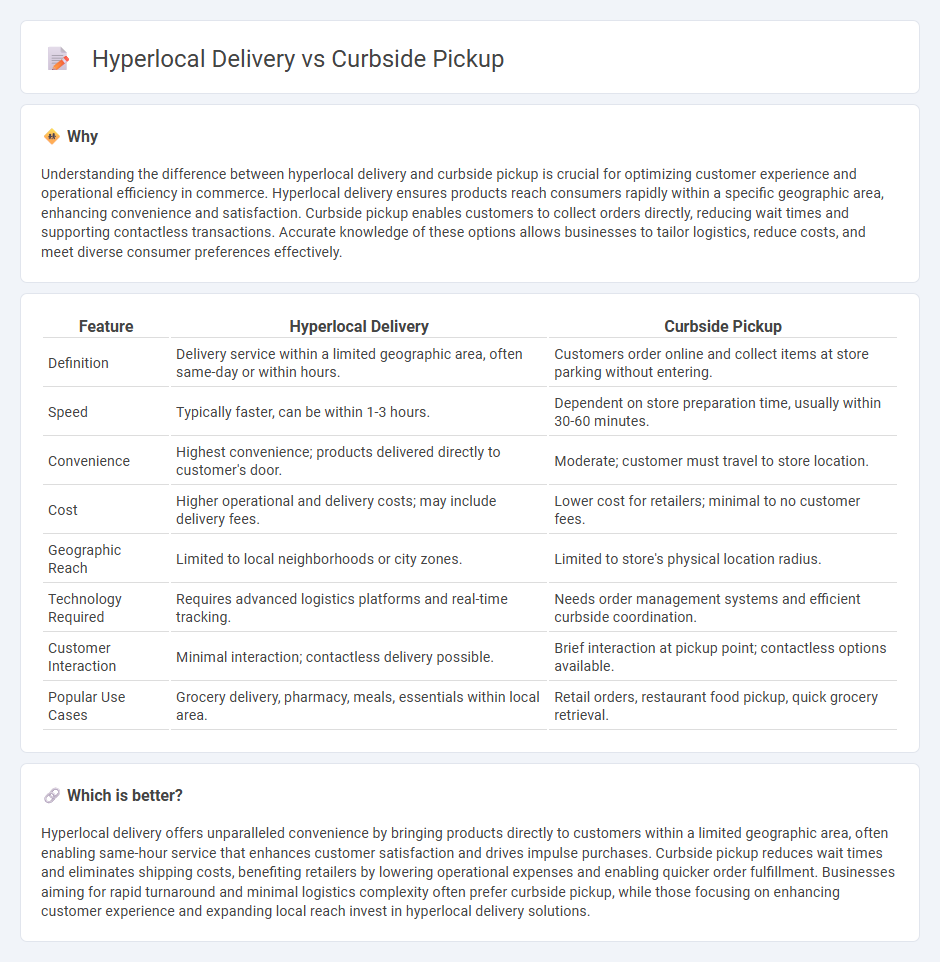
Hyperlocal delivery offers rapid, location-specific order fulfillment, enhancing customer convenience by minimizing wait times and expanding access to local businesses. Curbside pickup provides a seamless shopping experience where customers collect purchases directly from store premises, reducing delivery logistics and contact. Explore the detailed comparison of hyperlocal delivery and curbside pickup to optimize your retail strategy.
Why it is important
Understanding the difference between hyperlocal delivery and curbside pickup is crucial for optimizing customer experience and operational efficiency in commerce. Hyperlocal delivery ensures products reach consumers rapidly within a specific geographic area, enhancing convenience and satisfaction. Curbside pickup enables customers to collect orders directly, reducing wait times and supporting contactless transactions. Accurate knowledge of these options allows businesses to tailor logistics, reduce costs, and meet diverse consumer preferences effectively.
Comparison Table
| Feature | Hyperlocal Delivery | Curbside Pickup |
|---|---|---|
| Definition | Delivery service within a limited geographic area, often same-day or within hours. | Customers order online and collect items at store parking without entering. |
| Speed | Typically faster, can be within 1-3 hours. | Dependent on store preparation time, usually within 30-60 minutes. |
| Convenience | Highest convenience; products delivered directly to customer's door. | Moderate; customer must travel to store location. |
| Cost | Higher operational and delivery costs; may include delivery fees. | Lower cost for retailers; minimal to no customer fees. |
| Geographic Reach | Limited to local neighborhoods or city zones. | Limited to store's physical location radius. |
| Technology Required | Requires advanced logistics platforms and real-time tracking. | Needs order management systems and efficient curbside coordination. |
| Customer Interaction | Minimal interaction; contactless delivery possible. | Brief interaction at pickup point; contactless options available. |
| Popular Use Cases | Grocery delivery, pharmacy, meals, essentials within local area. | Retail orders, restaurant food pickup, quick grocery retrieval. |
Which is better?
Hyperlocal delivery offers unparalleled convenience by bringing products directly to customers within a limited geographic area, often enabling same-hour service that enhances customer satisfaction and drives impulse purchases. Curbside pickup reduces wait times and eliminates shipping costs, benefiting retailers by lowering operational expenses and enabling quicker order fulfillment. Businesses aiming for rapid turnaround and minimal logistics complexity often prefer curbside pickup, while those focusing on enhancing customer experience and expanding local reach invest in hyperlocal delivery solutions.
Connection
Hyperlocal delivery and curbside pickup both enhance customer convenience by enabling faster, location-specific order fulfillment in commerce. These services leverage local inventory and real-time order processing to reduce delivery times and optimize last-mile logistics. Retailers integrating hyperlocal delivery with curbside pickup improve operational efficiency while offering flexible shopping options that meet growing consumer demand for immediacy and safety.
Key Terms
Fulfillment Model
Curbside pickup streamlines order fulfillment by enabling customers to collect items directly from a nearby store, reducing delivery times and costs while leveraging existing retail infrastructure. Hyperlocal delivery optimizes last-mile logistics by partnering with local couriers to provide rapid, on-demand delivery within a defined geographic area, enhancing customer convenience and satisfaction. Explore the detailed advantages of each fulfillment model to determine the best fit for your business needs.
Delivery Radius
Curbside pickup typically limits the delivery radius to the store's immediate vicinity, ensuring quick and convenient customer access. Hyperlocal delivery expands this radius by leveraging local couriers to cover broader neighborhoods within a short time frame. Explore the advantages of each approach to optimize your last-mile delivery strategy.
Customer Convenience
Curbside pickup offers customers the convenience of quickly retrieving their orders without leaving their vehicles, reducing wait times and enhancing safety. Hyperlocal delivery brings the product directly to the customer's doorstep within a short radius, providing unmatched ease for those unable or unwilling to travel. Explore how these methods optimize customer convenience and which suits your lifestyle best.
Source and External Links
How Does Curbside Pickup Work? Everything you need to know - Curbside pickup involves placing an order online or via mobile, then driving to the store where staff deliver the order to your car using location technology for efficient, contactless service.
Trash - DSNY - NYC.gov - NYC offers free weekly curbside trash and recycling collection to residents with specific bin and set-out requirements to keep the city clean and maintain order on sidewalks.
Curbside Pickup - Mr T Carting - Mr. T Carting provides curbside garbage and recycling pickup service for NYC businesses without onsite storage space, following new regulations requiring waste to be in secure bins set out at curbside.
 dowidth.com
dowidth.com